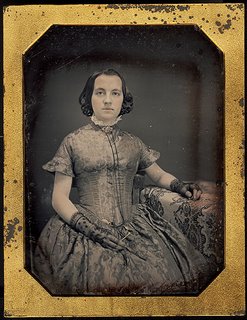History of Photography: Niépce to Eastman
I'm not sure how much this will actually help you in your photography, but it is interesting to know the early history of photographic technology.
For centuries artists have used the camera obscura as an aid to drawing. To make one, all you need do is poke a pin-sized hole into a box. Light will travel through the hole and project the scene from the other side of the box onto the back of the box or an object placed inside it.. Artists using this technique would then sketch what shapes fell onto the target area.
 Then along came Nicéphore Niépce. In 1826 he produced the first photographs using a camera obscura and chemicals in paper. His techniques produced a positive image on paper. They took hours upon hours in direct sunlight, and produced the image at the same time as the paper was exposed. At right you can see his earliest surviving image.
Then along came Nicéphore Niépce. In 1826 he produced the first photographs using a camera obscura and chemicals in paper. His techniques produced a positive image on paper. They took hours upon hours in direct sunlight, and produced the image at the same time as the paper was exposed. At right you can see his earliest surviving image. Louis Daguerre, another Frenchman, teamed up with Niépce, and together they refined the process. After Niépce's death, Daguerre continued to work. He discovered a way to make a latent image on the target object, which was later developed. In 1839 he introduced the Daguerreotype: a positive image on a copper plate. These were very high-quality images (see image at left), but since they were positive images they couldn't readily be copied. In this way they are much like Polaroids, except they are much more archival, as long as you don't scratch them (which is quite easy to do). Many of these images still survive today, and can fetch quite a price. On eBay at press time the beautiful picture at left is available, and bidding is currently at $208.50.
Louis Daguerre, another Frenchman, teamed up with Niépce, and together they refined the process. After Niépce's death, Daguerre continued to work. He discovered a way to make a latent image on the target object, which was later developed. In 1839 he introduced the Daguerreotype: a positive image on a copper plate. These were very high-quality images (see image at left), but since they were positive images they couldn't readily be copied. In this way they are much like Polaroids, except they are much more archival, as long as you don't scratch them (which is quite easy to do). Many of these images still survive today, and can fetch quite a price. On eBay at press time the beautiful picture at left is available, and bidding is currently at $208.50.About the same time, William Fox Talbot was working on a process to make negative images that could later be printed into positives. His process was called calotype. They were not as high-quality as the Daguerreotypes, and not as long-lived either.
 Many others contributed to this process over time. Not the least of which was George Eastman, founder of Kodak, who introduced a camera that was preloaded with a roll of film (about 100 exposures) and was turned into the company to be developed, not unlike the disposable cameras of today (diagram at right). They didn't have a viewfinder of any sort, but despite this flaw it made photography available to the general public at the then-quite-expensive but still affordable price of $25, inclusive of processing. The slogan: "You press the button, we do the rest." And the rest is, as they say, history.
Many others contributed to this process over time. Not the least of which was George Eastman, founder of Kodak, who introduced a camera that was preloaded with a roll of film (about 100 exposures) and was turned into the company to be developed, not unlike the disposable cameras of today (diagram at right). They didn't have a viewfinder of any sort, but despite this flaw it made photography available to the general public at the then-quite-expensive but still affordable price of $25, inclusive of processing. The slogan: "You press the button, we do the rest." And the rest is, as they say, history.

0 Comments:
Post a Comment
<< Home